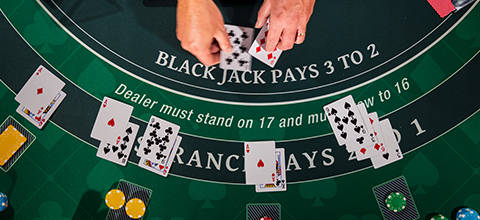
Differences Between Blackjack & Pontoon
Card games are some of the most popular games in the world, and it’s easy to understand why. You can grab a deck of cards and carry it with you wherever you go, and it’s simple to play whenever the mood strikes. Two of the most well-known and beloved card games among casino visitors are blackjack and pontoon. While they are sometimes used interchangeably, blackjack and pontoon are their own distinct games. In this article, we’ll explore the differences between them so that you can find the perfect fit for your playstyle.
What is blackjack?
Blackjack is possibly the most popular table game in today’s global casinos. Most historians agree that it dates back to the 1700s – it was likely played in French casinos – and it has been a popular title ever since. Part of this popularity comes from the game’s rules, which are easy to understand. Players are dealt two cards, and their goal is to create a hand as close to 21 as possible without going over. On their turns, players can either add a card to their hands (hit), stick with their current hands (stand), double down their bets, split their hands, or call out a natural blackjack.
As you can see, it’s simple to play blackjack. However, it’s deceptively hard to master. This dichotomy keeps our players coming back day in and day out.
What is pontoon?
Players who are new to card games are often unfamiliar with pontoon, especially if they’re from outside of the UK. So, what is pontoon? Sometimes referred to as a variant of blackjack, pontoon has similar rules and goals to blackjack but has a slightly shorter history. Some historians think that it originated in the UK in the 1800s (which makes sense given its popularity here), while others believe that it’s more closely related to a Spanish card game known as ‘veintiuna’.
Regardless of its exact origins, pontoon is a particularly well-known game in Europe and many players enjoy playing it both in live casino sites online and at in-person events. Similar to blackjack, the goal of pontoon is to get to 21 without going over. This is where the blackjack & pontoon differences come into play. Players are dealt two cards and can ‘twist’ to add more cards to their hand, ‘stick’ to stand, ‘split’ to split their hand, or ‘buy’ to double down. A 21-point hand in pontoon is fittingly known as a ‘pontoon’, not a blackjack.
Similarities between blackjack and pontoon
The main similarities between blackjack and pontoon are the goal of reaching 21 as well as the use of a standard 52-card deck. Note that while gameplay terms vary between the two, both games also have very similar rules and mechanics (as briefly described above). Players of both titles can add cards to their hands, stand on their hands, double their wagers, and split their hands, among others.
Key differences between blackjack and pontoon
What are the differences between blackjack and pontoon? The main differences are in the terminology, card dealing and payouts for winning hands.
Terminology
Blackjack uses the terms ‘hit’ and ‘stand’ to describe adding cards and not adding cards to hands. Pontoon uses the terms ‘twist’ and ‘stick’ to add and not add cards, respectively.
Card dealing and visibility
One of the main blackjack differences to pontoon comes in the way that the cards are dealt. In blackjack, the dealer’s initial two cards are dealt one card up and one card down. In pontoon, the dealer, also known as the banker, deals both their cards face down.
Winning hands and payouts
Pontoon and blackjack differ in terms of winning hand payouts. In general, pontoon offers higher payouts for certain hands compared to blackjack. More specifically, pontoon’s payout structure is 2:1, while blackjack only has a 3:2 payout.
Rules for dealer and player actions
In pontoon, players must hit with a card value of less than 15; they cannot stand. In blackjack, players can stand on lower-value hands. Doubling down (also known as ‘buying’ in pontoon) also functions differently between the two games. In blackjack, when you double down, you receive one extra card. In pontoon, you can buy and then take as many extra cards as you like.
Strategies for playing blackjack and pontoon
In blackjack, most strategy is based around the dealer’s hand (remember, one of their initial two cards is dealt face up). Depending on their face card value, players hit, stand, double down or split as they see fit. In pontoon, where players can’t see the dealer’s cards, strategies revolve mostly around the player’s hand. Doubling down on an 11, for example, is a strategy that’s unique to pontoon.
If you want the best chance of winning, you must pay attention to specific game rules and house edges. This is even true of individual tables, where home rules and house edges sometimes differ from traditional gameplay.
Common misconceptions about blackjack and pontoon
Some players go into a pontoon game expecting blackjack, and vice versa. Unfortunately, both games are distinct and sometimes the rules just don’t match up. Strategy is another area where misconceptions are common. Some players believe that pontoon, unlike blackjack, are all luck, but that’s not the case. There are effective strategies for pontoon just as there are for blackjack.
Conclusion
Blackjack and pontoon are two similar, but distinct, card games. Both of them use a standard deck, have similar mechanics, and share an overall goal of reaching 21, but there are also some differences. The terminology differs between them, for example, as do some rules regarding dealer hands and doubling down. Consider trying both to find the perfect fit for your personal preference.